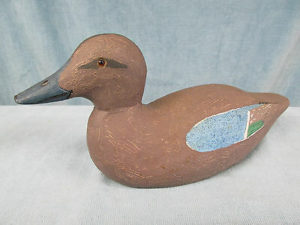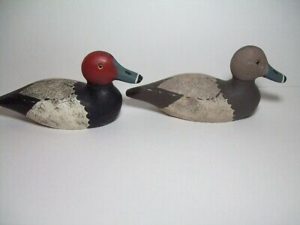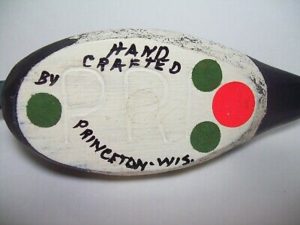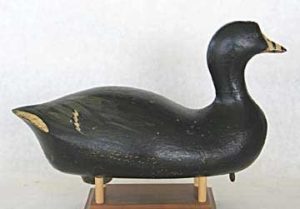The “Duckman” of Princeton, WI
A Decoy Corner Article by Bruce Urben, President
Paul R. Doering was born in 1899 and began carving decoys in the early 1930’s, shortly after his marriage to Minnie Zellmer. Minnie was a daughter, sister, niece and mother to a legendary crew of Lake Puckaway waterfowlers, trappers and guides. Paul worked at the Rosenberg Elevator Company in Milwaukee until his retirement in the 1960’s. While working he spent his spare time and weekends with his in-laws on Lake Puckaway helping them run their resort, waterfowling, guiding and carving decoys. He eventually moved to Princeton, Wisconsin after his retirement. It has been said that the great grandfather of Paul’s wife Minnie actually sold property to the initial investors of NeePeeNauk lodge back in the 1870’s – for $10 and a bottle of whiskey.
 Paul began dabbling in decoy carving, first making repairs and repainting hand-me-down blocks. After carving new heads for dilapidated decoys, he finally began carving his own. His first carved rig consisted of 25 bluebills and 25 canvasbacks. He provided many of the decoys for the NeePeeNauk Duck Club on Lake Puckaway through the 1950’s. According to Paul’s family, many of his early decoys have vanished except for several 1930 examples that remain in his family’s hands. Paul became famous for the decoys he began carving in the 1960’s, carving hundreds per year.
Paul began dabbling in decoy carving, first making repairs and repainting hand-me-down blocks. After carving new heads for dilapidated decoys, he finally began carving his own. His first carved rig consisted of 25 bluebills and 25 canvasbacks. He provided many of the decoys for the NeePeeNauk Duck Club on Lake Puckaway through the 1950’s. According to Paul’s family, many of his early decoys have vanished except for several 1930 examples that remain in his family’s hands. Paul became famous for the decoys he began carving in the 1960’s, carving hundreds per year.
Doering was a throw back to the old-time carver. He initially used Mason decoys for his patterns, but later made his own patterns and turned out almost all species of ducks except pintails (you will not find any Doering pintails). Paul’s decoys were in great demand and he began to be known as the “Duckman” of Princeton. Collectors snapped up his decoys as soon as they were finished; in fact, at one time in the late 60’s he was over 2 years behind in filling his orders. He eventually stopped taking orders entirely. Paul also carved a large number of miniature decoys that were also highly collected.
 Paul’s decoys had several distinguishing characteristics. His early blocks have his initials carved in capital letters on the decoy bottom (PRD) very crisp and cleanly. Later, Doering’s decoys had a brand that was somewhat eroded. His late decoys had his handwritten signature, gender and species designation on the bottom. Many also had a bright orange circular label on the bottom.
Paul’s decoys had several distinguishing characteristics. His early blocks have his initials carved in capital letters on the decoy bottom (PRD) very crisp and cleanly. Later, Doering’s decoys had a brand that was somewhat eroded. His late decoys had his handwritten signature, gender and species designation on the bottom. Many also had a bright orange circular label on the bottom.
Doering’s decoys were rugged – “working style” wood decoys. The bills on early examples were spindly, but later were quite chunky. He painted with oils and was known to have imported some of his paints from Germany.
Paul Doering decoys are still in high demand, particularly by Wisconsin collectors, and can still be found on the secondary auction market. Early decoys are valued at $50-$200 and his later decoys range from several hundred on up.
 Paul Doering passed away in 1986 at the age of 87 years.
Paul Doering passed away in 1986 at the age of 87 years.
I was fortunate to recently find an early Paul Doering bluebill decoy branded with his PRD initials at a Michigan auction and will enjoy his work as another true Wisconsin Original on my shelf.
As always, consult with a reputable collector or dealer in identifying or valuing any vintage decoy before you acquire it.
